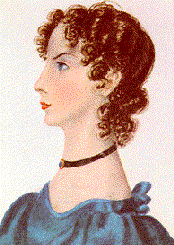 The Tenant of Wildfell Hall by Anne Bronte
The Tenant of Wildfell Hall by Anne BronteThough Anne Bronte isn't near as well known as her sisters, Charlotte and Emily, her book, The Tenant of Wildfell Hall deserves to stand out as a classic alongside Jane Eyre and Wuthering Heights. Personally, I liked Jane Eyre better, but found Tenant of Wildfell Hall a much better book than Wuthering Heights because I found Tenant's lead character a stronger protagonist and it made an interesting commentary to her sister's books.
Helen Graham-Huntington arrives in a village becoming the target of gossip and scandal among the locals. She also becomes the object of local landowner Gilbert Markham's affections. At first, he is enamored and jealous of the woman even attacking a man that he mistakes to be her lover. But then he learns of her story and becomes a better character defending her against attacks.
The middle half of the book which recounts Helen's story is better than the beginning. Here we find Helen, a passionate young woman determined to marry for love. What she gets instead is Arthur Huntington, a charismatic and brutal man who devolves into an abusive alcoholic.
The Tenant of Wildfell Hall has a very strong female lead with Helen. While she is in an impossible situation, she never allows herself to lose her resolve. She saves money and paints on the side to earn a living to leave. She lectures and protects her young son, hoping for him not to end up like his father. She also does what many women of her day would not do: she leaves him to start a new life. She is a much better character than either of her suitors, the abusive, Arthur and brash, Markham.
The other point of interest with Tenant is how it stands in relation to Anne's sister's works. While Charlotte and Emily Bronte's works are more Romantic and passionate in nature, Anne's appears to be more Realistic. In her writing Anne Bronte's characters live in dark creepy mansions in the country and have forbidden secrets but they still deal with real world problems, such as alcoholism, infidelity, divorce.It's almost as though Anne were saying "This is what really would happen if Cathy had married Heathcliff and lived all her life in isolation. It's not pretty is it?"
The Tenant of Wildfell Hall could stand to be a commentary on Anne's sister's books the Realism that contrasts with the Romance making a complete picture of the sisters' works and lives.
Link For Further Discussion And Activity Suggestions:
 |
| http://digital.library.upenn.edu/women/bronte/bronte-anne.html |
Click on the picture and the link to learn more about the "forgotten younger" Bronte sister and how she should be considered an equal to Emily and Charlotte in terms of writing. What topics do she and her sister write about? How are they similar and different? Imagine that you were the characters in one Bronte novel remarking on the behaviors of another? What would they say? Would they get along or not?
The Literary Gothic - The Bronte sisters are part of the Gothic literary genre. Read through the definition of gothic on this site. What are the Gothic properties in Tenant of Wildfell Hall? Whate does Gothic look like, sound like, or read like? How is that definition changed with such movements like "The Goth" subculture? What other literary movements are there and what works could be a representation of that specific movement?
Questions for Discussion:
1. Compare the three works by The Bronte sisters, Anne, Charlotte, and Emily. How is The Tenant of Wildfell Hall considered an answer to Jane Eyre or Wuthering Heights. How are the works similar and how are they different?
2. How does Helen's character change before she meets Arthur and after her marriage? How does she exhibit strength and weaknesses? Look at the final scenes with Arthur. Do you agree with her decision? Why or why not? Does she really show forgiveness? Why is that important for her?
The Literary Gothic - The Bronte sisters are part of the Gothic literary genre. Read through the definition of gothic on this site. What are the Gothic properties in Tenant of Wildfell Hall? Whate does Gothic look like, sound like, or read like? How is that definition changed with such movements like "The Goth" subculture? What other literary movements are there and what works could be a representation of that specific movement?
Questions for Discussion:
1. Compare the three works by The Bronte sisters, Anne, Charlotte, and Emily. How is The Tenant of Wildfell Hall considered an answer to Jane Eyre or Wuthering Heights. How are the works similar and how are they different?
2. How does Helen's character change before she meets Arthur and after her marriage? How does she exhibit strength and weaknesses? Look at the final scenes with Arthur. Do you agree with her decision? Why or why not? Does she really show forgiveness? Why is that important for her?




